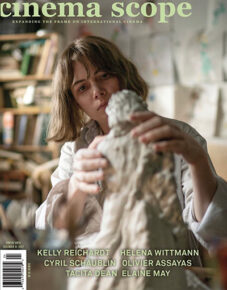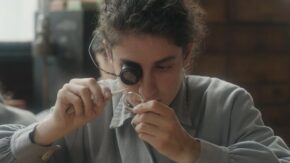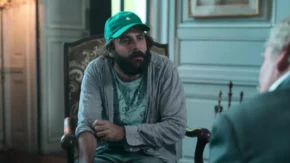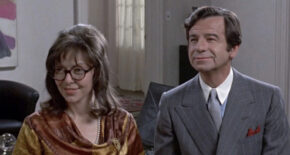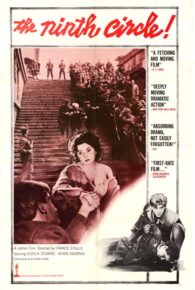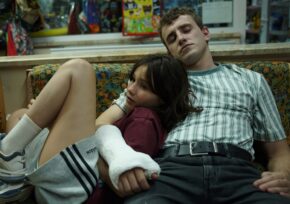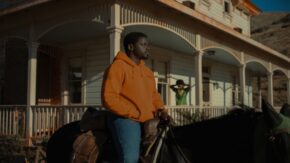CS92
The Sea Inside: Helena Wittmann on Human Flowers of Flesh
By Jordan Cronk | 04/19/2023 | Cinema Scope Online, CS92
By Jordan Cronk Among a new generation of German filmmakers, Hamburg’s Helena Wittmann is uniquely elemental, even primal, in her concerns. For over a decade, the 39-year-old artist has been exploring the outer reaches of cinematic storytelling through the medium’s singular ability to transform not only space and time, but also the spectator’s relationship with…
Read More → Enys Men (Mark Jenkin, UK)
By Angelo Muredda | 03/20/2023 | Cinema Scope Online, CS92
By Angelo Muredda A woman’s observation that lichen has started to grow on a flower she’s been studying for weeks counts as bold narrative progress in Mark Jenkin’s decidedly low-stakes folk-horror curio, Enys Men. Shot in the same striking, hand-processed 16mm stock and set in the same seaside milieu as the director’s lauded feature debut…
Read More → Cinema Scope Issue 92 | Table of Contents
By Cinema Scope | 09/27/2022 | CS92, From Cinema Scope Magazine, Table of Contents
Interviews with Kelly Reichardt, Cyril Schäublin, Olivier Assayas. Features, Columns and more.
Read More → Take These Broken Wings: Kelly Reichardt on “Showing Up”
By Adam Nayman | 09/27/2022 | CS92, From Cinema Scope Magazine, Interviews
“We thought we were writing a film that was partly comedic in tone. I can find a lot to laugh at with liberal arts while still believing liberal arts are super-important. Some of the situations in Showing Up are comical, but the people aren’t stereotypes—we really tried to stay away from that.”
Read More → Timely Circumstances: Cyril Schäublin on “Unrest”
By Jay Kuehner | 09/27/2022 | CS92, From Cinema Scope Magazine, Interviews
I think this is the critical question now: how do we chart our history? How do we reimagine a truer solidarity? Maybe the film allows us to imagine other possibilities.
Read More → What Is Cinema? Olivier Assayas on “Irma Vep”
By Beatrice Loayza | 09/26/2022 | CS92, From Cinema Scope Magazine, Interviews
With both versions of Irma Vep,Assayas looks tothe ruptures between the production processes and moviemaking cultures of then and now to create comedy and tragedy about what it means to want to continue the fight, the folly, that is making movies, continuously posing that vital and unanswerable question—“What is cinema?”—in order to recalibrate our perception of what it could be and what it’s not amid such endless reinvention and recontextualization.
Read More → Telling the Truth Can Be Dangerous Business: The Overdue Enshrinement of Elaine May
By Christoph Huber | 09/26/2022 | CS92, Features, From Cinema Scope Magazine, TV
It’s not as if Elaine May wasn’t a beloved figure in American popular culture for most of her life. Her successful pairing with Mike Nichols as an innovative improv comedy team in the late ’50s may have been short-lived—the duo broke up at the height of their success in 1961—but is regularly cited as one of the most influential and well-remembered comedy acts the US has ever known.
Read More → Can the Centre Hold?: The Films of Adirley Queirós
By James Lattimer | 09/26/2022 | CS92, Features, From Cinema Scope Magazine
The periphery is always the centre in the films of Adirley Queirós, whether in terms of the people and places at the focus of his attention or the off-centre stylistic means he employs to explore their tribulations, and, by extension, those of Brazil.
Read More → Cinema Scope Magazine 92: Editor’s Note
By Mark Peranson | 09/26/2022 | Columns, CS92, From Cinema Scope Magazine
we shouldn’t forget the reasons why we all got into this job in the first place, which is the promotion of film as an art form. The impact that festivals have on general art-house distribution should not be overlooked; of course, as touched on above, sometimes it’s the distributor who decides to skip festival screenings for certain films, because everyone has their reasons.
Read More → TV or Not TV | Finding Fielder: “The Rehearsal”
By Kate Rennebohm | 09/26/2022 | Columns, CS92, From Cinema Scope Magazine, TV, TV or not TV
Nathan Fielder’s newest television show, The Rehearsal—which was renewed for a second season at the recent close of its dizzying six-episode run on HBO—is a true comedy, in the sense that it’s really a tragedy. A deeply funny show wrapped around a startling core of sadness, The Rehearsal sets its sights on the tangled notion that the more we instrumentalize or attempt to control the world, the more the reality of that world and those in it seems to escape us.
Read More → Global Discoveries on DVD: Bologna’s Bounty
By Jonathan Rosenbaum | 09/26/2022 | Columns, CS92, DVD Reviews, From Cinema Scope Magazine
There appears to be a consensus that this year’s Il Cinema Ritrovato in Bologna was exceptionally rich—so much so that I concluded that my next column in these pages could be devoted to some of its riches, most of which are already available on DVD or Blu-ray in one form or another.
Read More → Film/Art | Evidence Visible from a Distance: Tacita Dean on Fata Morgana
By Antoine Thirion | 09/26/2022 | Books, Columns, CS92, Film - Art, Interviews
In The Green Ray (2001), British artist Tacita Dean famously managed to capture on 16mm film the fleeting light that the sun leaves behind right at the moment when it disappears from the horizon. And, because a digital camera used by others at the same time, on the same beach, was unable to capture it, her film proves two things: one, that the green ray, despite being missed by almost all who try and see it, is not a legend; two, that only film can capture it. But the evidence is elusive, as Éric Rohmer found out while shooting Le rayon vert (1986), eventual
Read More → Aftersun (Charlotte Wells, UK/US)
By Jason Anderson | 09/26/2022 | CS92, Currency, From Cinema Scope Magazine
The image of Paul Mescal lost and losing himself in a crowded, strobe-lit dancefloor is the most haunting leitmotif in Charlotte Wells’ debut feature Aftersun, a film that would be acutely musical in feel and structure even if it weren’t powered by such a carefully curated selection of underappreciated late-’90s UK chart faves (All Saints and Chumbawamba included). As glimpsed in the flickering light, his face expresses both the loved-up chemical bliss expected of the era’s aging ravers and a more disquieting sense of vacancy; it’s as if he’s not all there. And while that phrase risks being more suggestive of some garden-variety weekender blasted
Read More → Alcarràs (Carla Simón, Spain/Italy)
By Saffron Maeve | 09/26/2022 | CS92, Currency, From Cinema Scope Magazine
By Saffron Maeve A pejorative superficially on par with its sister terms Big Pharma and Big Tech, which imply a gadgety reshaping of the natural world, Big Ag looms heavy over the sunny fields of Carla Simón’s acclaimed Alcarràs, which was awarded the Golden Bear at this year’s Berlinale and exceeded all box-office expectations upon…
Read More → Nope (Jordan Peele, US)
By Robert Koehler | 09/26/2022 | CS92, Currency, From Cinema Scope Magazine
Whatever else you may have heard about Nope, otherwise known as “Not of Planet Earth,” know this: Jordan Peele’s third and most radical movie is his subversive inquiry into Hollywood. On the surface, such a stance is old news. At least as early as Nathaniel West’s The Day of the Locust, artists who have experienced the Hollywood moviemaking business firsthand have exacted some form of literary or cinematic revenge at the beast that has fed them. The irony is that it can sometimes seem that it’s some of the most successful in the Hollywood galaxy who engage in this project, whether it be Vincente Minnelli with The Bad and the Beautiful (1952), Paul Mazursky with Alex in Wonderland (1970), or Robert Altman with The Player (1992).
Read More → 


